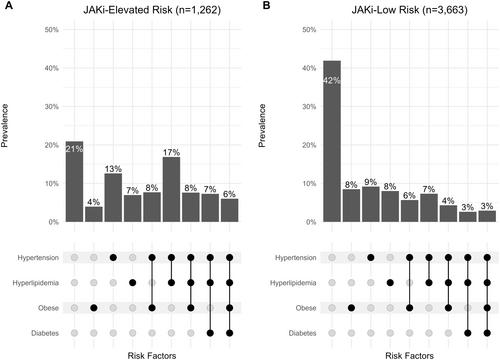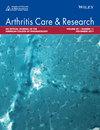Prevalence of Cardiovascular and Cancer Risk Factors Among Rheumatoid Arthritis Patients Prescribed JAK Inhibitors and Tumor Necrosis Factor Inhibitors: A Cross-Sectional Study
Abstract
Objective
The study was to determine the prevalence of baseline risk factors for cardiovascular outcomes and cancer among commercially-insured patients with rheumatoid arthritis (RA) during their first dispensed treatment for either tumor necrosis factor inhibitors (TNFi) or JAK inhibitors (JAKi).
Methods
Patients with RA from August 16, 2019 to March 31, 2022 were identified in the Merative MarketScan Commercial and Medicare databases. The first date that a TNFi or JAKi was dispensed was the index date, and baseline risk factors were assessed among patients continuously eligible for 12 months before the index date. Patients who had the following were stratified into an elevated risk category: age ≥65 years, smoking, or a history of a major adverse cardiovascular event, venous thromboembolism, or cancer. The prevalence of modifiable risk factors was also reported: hypertension, hyperlipidemia, obesity, and diabetes. The crude prevalence and prevalence difference (PD) were reported.
Results
A total of 12,673 patients (TNFi [n = 7,748; 61%] and JAKi [n = 4,925; 39%]) met inclusion criteria. The prevalence of elevated risk was the same for all patients using TNFi (n = 2,051; 26%) and JAKi (n = 1,262; 26%). Compared with patients having low risk, patients with an elevated risk also had a higher prevalence of at least one primary modifiable risk factor for both patients using JAKi (79% vs 58%; PD 21%, 95% confidence interval [CI] 18%–24%) and TNFi (81% vs 60%; PD 21%, 95% CI 19%–23%).
Conclusion
In recent years, JAKi and TNFi were used in similar proportions to treat RA among commercially-insured patients at elevated cardiovascular and cancer risk. Because uncontrolled disease, modifiable comorbidities, and treatment with JAKi are associated with these adverse events, future studies evaluating how practice patterns may be affected by the emergence of safety data will be of value.


 求助内容:
求助内容: 应助结果提醒方式:
应助结果提醒方式:


